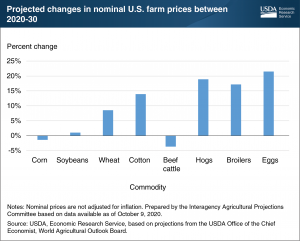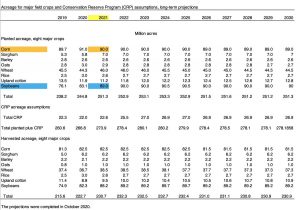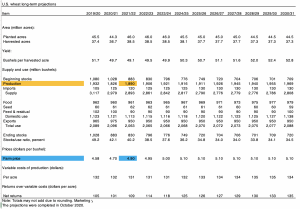Beef prices are projected to continue increasing as U.S. beef production declines with no signs of a cattle herd rebuild. Additionally, cheap beef may soon become further out of reach…
USDA Agricultural Projections Show Increased Soybean Acres in 2021
On Friday, the USDA’s Office of the Chief Economist (OCE) released selected tables prepared for the Department’s upcoming Agricultural Baseline Projections report.
The Department pointed out that, “The projections use as a starting point the short-term forecasts from the October 9, 2020 World Agricultural Supply and Demand Estimates report.
With respect to commodity prices, the USDA’s Economic Research Service explained that, “USDA projections for changes in nominal (not adjusted for inflation) U.S. farm prices between 2020 and 2030 indicate a mixed outlook shaped by the expected recovery in U.S. and global demand, continued export competition, and market conditions during 2020.
For crops, the strongest gains are projected for wheat and cotton. Wheat prices are projected to rise as domestic and export demand begin to outpace domestic production, while higher cotton prices are driven by a projected recovery in export demand.
“Modest changes in prices for U.S. corn and soybeans from current levels reflect the relatively steady demand for these products during 2020, together with the moderating influences of productivity gains and continued export competition. Among livestock products, farm prices of hogs, broilers, and eggs are projected higher by 2030, as economic recovery restores growth in domestic and export demand. U.S. beef cattle prices are expected to rise during the early years of the 10-year projection period, before declining somewhat as the multi-year cattle cycle and a longer-term trend of sluggish demand growth turn prices downward.

“The projections are based on an assumed long-term macroeconomic outlook that includes a recovery in income growth—beginning in 2021—from the declines that have occurred in most economies during 2020. The outlook for the U.S. economy, and for many important U.S. agricultural markets and competitors, however, remains uncertain.”
Baseline projection tables show most crop prices are anticipated to rise relative to last year’s projections, driven by improved export prospects & lower inventories. But global macroeconomic conditions have diminished some prospects for cotton. https://t.co/X54rytfoJF pic.twitter.com/4WNzgk5NAm
— USDA Office of the Chief Economist (@usda_oce) November 6, 2020
With respect to acreage, Friday’s update pointed to an increase in total planted acres in 2021.

According to Baseline tables, total acreage of barley, corn, cotton, oats, rice, sorghum, soybeans, and wheat is projected to reach 251.3 million in 2021/22, the largest since 2018/19. https://t.co/X54rytfoJF pic.twitter.com/9XEOfxcEYL
— USDA Office of the Chief Economist (@usda_oce) November 6, 2020
More narrowly, soybean acreage in 2021 is projected to climb to 89 million acres.
USDA's long-term projections suggests U.S. farmers will plant 89 million acres of #soybeans in 2021, drastically more than this year. Total use in 2021/22 is seen flat on 2020/21, but combined with supply it brings ending stocks just a bit lower on the year. pic.twitter.com/ToYmrcYrYM
— Karen Braun (@kannbwx) November 6, 2020
And corn acres in 2021 are projected down slightly.

Meanwhile, wheat acres in 2021 are projected somewhat higher.

The Department added that the complete USDA Agricultural Projections to 2030 report will be released in February 2021.





